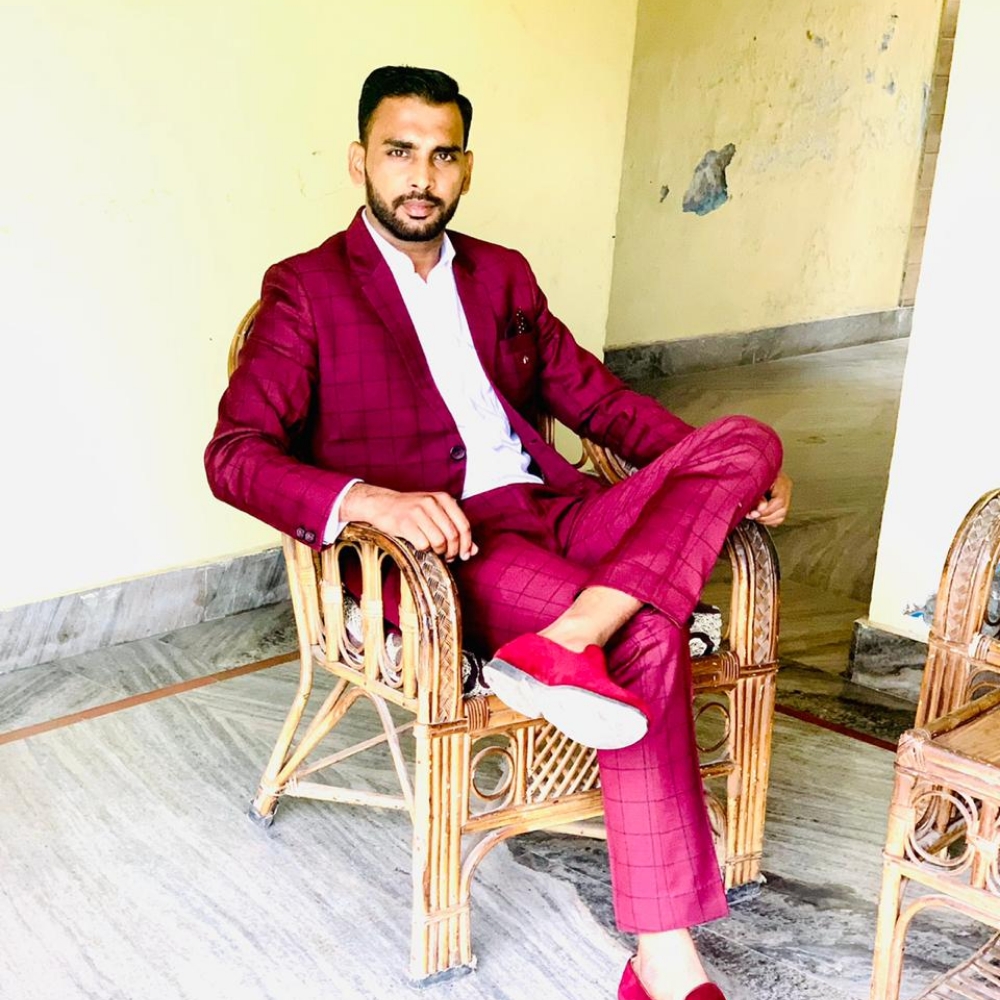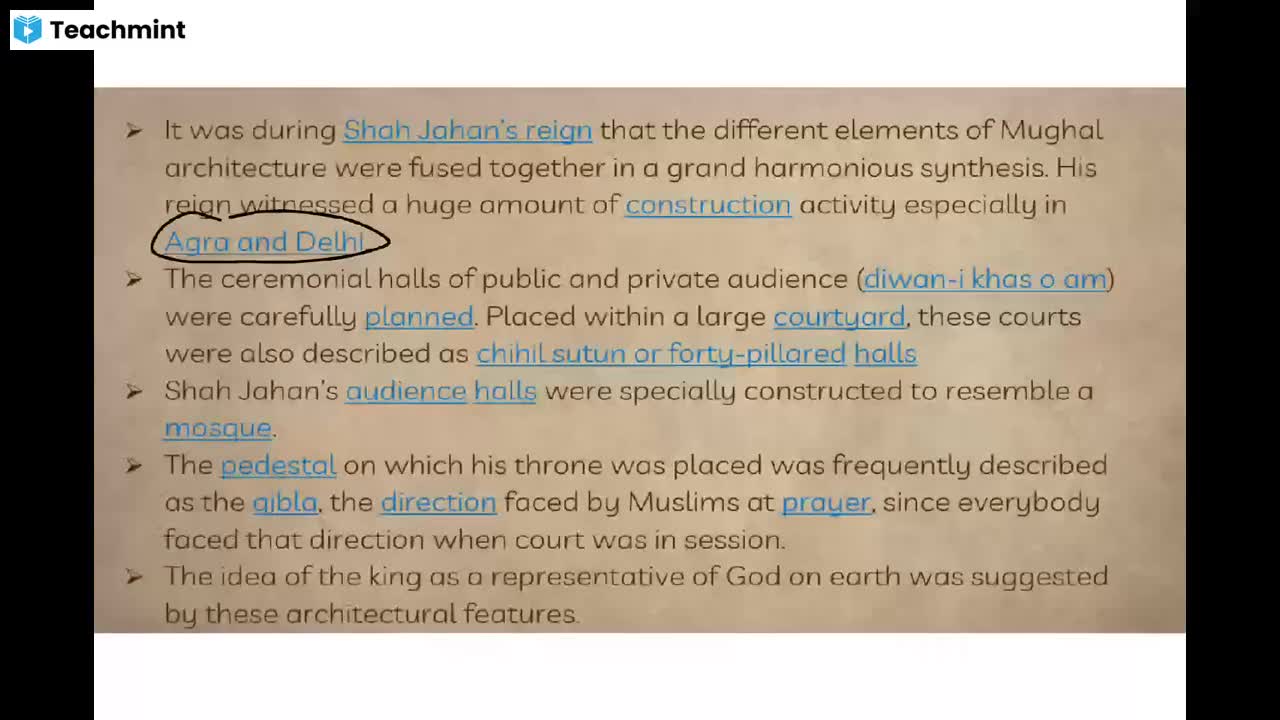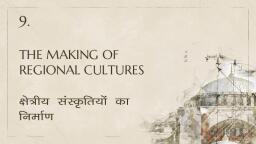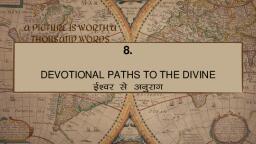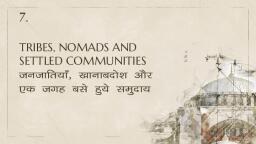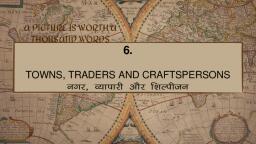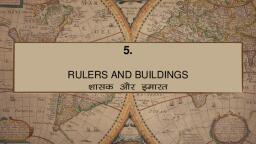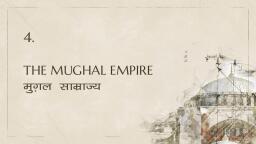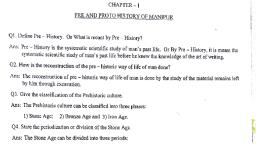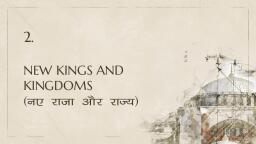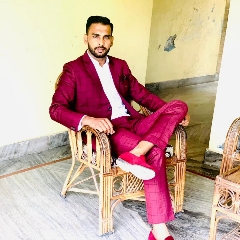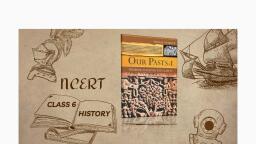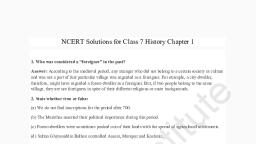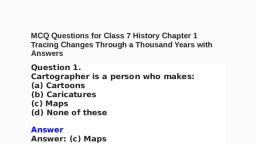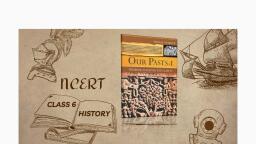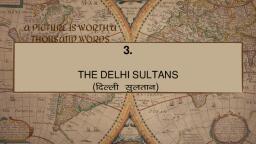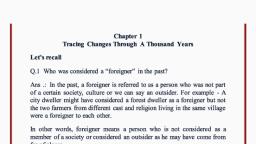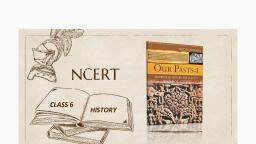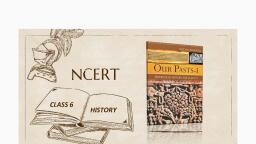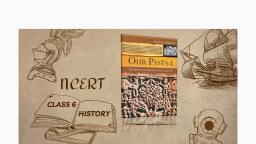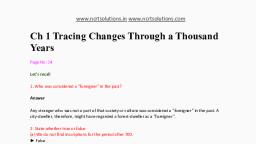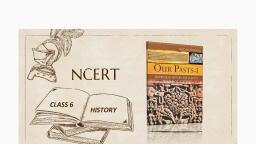Page 1 :
CONTENTS, 1., 2., 3., 4., 5., 6., 7., 8., 9., 10., , TRACING CHANGES THROUGH A THOUSAND YEARS, NEW KINGS AND KINGDOMS, THE DELHI SULTANS, THE MUGHAL EMPIRE, RULERS AND BUILDINGS, TOWNS, TRADERS AND CRAFTSPERSONS, TRIBES, NOMADS AND SETTLED COMMUNITIES, DEVOTIONAL PATHS TO THE DIVINE, THE MAKING OF REGIONAL CULTURES, EIGHTEENTH-CENTURY POLITICAL FORMATIONS
Page 3 :
OVERVIEW ?, 1., , 2., 3., 4., , 5., 6., , NEW AND OLD TERMINOLOGIES, HISTORIANS AND THEIR SOURCES, NEW SOCIAL AND POLITICAL GROUPS, REGION AND EMPIRE, LANGUAGE AND REGION, THINKING ABOUT TIME AND HISTORICAL PERIODS
Page 4 :
● Made in 1154 CE by the Arab, , geographer Al-Idrisi. The section, reproduced here is a detail of the, Indian subcontinent from his, larger map of the world., ● South India is where we would, expect to find north India and Sri, Lanka is the island at the top., Place-names are marked in, Arabic, and there are some wellknown names like Kanauj in Uttar, Pradesh (spelt in the map as, Qanauj).
Page 5 :
● The subcontinent, from the early-, , eighteenthcentury Atlas Nouveau, of Guillaume de l’Isle., ● Made in the 1720s by a French, cartographer (ekufp=kdkj)., ● Time information about the, subcontinent had changed, considerably. This map seems, more familiar to us and the, coastal areas in particular are, surprisingly detailed. This map, was used by European sailors and, merchants on their voyages
Page 6 :
NEW AND OLD TERMINOLOGIES('kCnkoyh), ● Historical records exist in a variety of languages which have changed, considerably over the years., ● For example:- Medieval Persian, is different from modern Persian. The, difference is not just with regard to grammar and vocabulary; the meanings of, words also change over time., ● Take the term “Hindustan”, for example. Today we understand it as “India”,, the modern nation-state. When the term was used in the thirteenth century by, Minhaj-i-Siraj, a chronicler who wrote in Persian, he meant the areas of, Punjab, Haryana and the lands between the Ganga and Yamuna. He used the, term in a political sense for lands that were a part of the dominions of the, Delhi Sultan. The areas included in this term shifted with the extent of the, Sultanate but the term never included south India.
Page 7 :
NEW AND OLD TERMINOLOGIES, ● By contrast, in the early sixteenth century Babur used Hindustan to describe, the geography, the fauna and the culture of the inhabitants of the, subcontinent., ● The fourteenth-century poet Amir Khusrau used the word “Hind”., ● While the idea of a geographical and cultural entity like “India” did exist, the, term “Hindustan” did not carry the political and national meanings which we, associate with it today., ● A simple term like “foreigner”. It is used today to mean someone who is not an, Indian. In the medieval period a “foreigner” was any stranger who appeared, say in a given village, someone who was not a part of that society or culture., (In Hindi the term pardesi might be used to describe such a person and in, Persian, ajnabi.)
Page 8 :
HISTORIANS AND THEIR SOURCES, ➢ There is some continuity in the sources used by historians for the study of this, period. They still rely on coins, inscriptions, architecture and textual records for, information. (flDdksa] f'kykys[kksa] LFkkiR; ( Hkou fuekZ.k dyk), ➢ But there is also considerable discontinuity. They slowly displaced other types of, available information. Through this period paper gradually became cheaper and, more widely available., ➢ People used it to write holy texts, chronicles of rulers, letters and teachings of, saints, petitions and judicial records, and for registers of accounts and taxes., Manuscripts were collected by wealthy people, rulers, monasteries and temples., They were placed in libraries and archives(vfHkys[kkxkjks). These manuscripts and, documents provide a lot of detailed information to historians but they are also, difficult to use.
Page 9 :
HISTORIANS AND THEIR SOURCES, ➢ There was no printing press in those days so scribes copied manuscripts, , by hand., ➢ As scribes copied manuscripts, they also introduced small changes – a, , word here, a sentence there. These small differences grew over centuries, of copying until manuscripts of the same text became substantially, different from one another. This is a serious problem because we rarely, find the original manuscript of the author today. We are totally, dependent upon the copies made by later scribes. As a result historians, have to read different manuscript versions of the same text to guess, what the author had originally written.
Page 10 :
HISTORIANS AND THEIR SOURCES, ➢ On occasion authors revised their chronicles at different times., ➢ The fourteenth-century chronicler Ziyauddin Barani wrote his chronicle, , first in 1356 and another version two years later. The two differ from, each other but historians did not know about the existence of the first, version until the 1960s. It remained lost in large library collections.
Page 11 :
➢ Different kinds of handwriting could make the reading of Persian and, , Arabic difficult. The nastaliq style (on the left) is cursive and easy to read,, the shikaste (on the right) is denser and more difficult
Page 12 :
➢ A painting of a scribe making a copy of a manuscript. This painting is, , only 10.5 cm by 7.1 cm in size. Because of its size it is called a miniature., Miniature paintings were sometimes, used to illustrate the texts of, manuscripts. They were so beautiful, that later collectors often took the, manuscripts apart and sold just the, miniatures.
Page 13 :
NEW SOCIAL AND POLITICAL GROUPS, (u, lkekftd vkSj jktuhfrd lewg)_, ➢ The study of the thousand years between 700 and 1750 is a huge, , challenge to historians largely because of the scale and variety of, developments that occurred over the period., ➢ At different moments in this period new technologies made their, appearance – like the Persianwheel in irrigation,, the spinning wheel in weaving, and, firearms in combat., New foods and beverages arrived in the subcontinent – potatoes, corn,, chillies, tea and coffee., ➢ As a result, this was a period of economic, political, social and cultural, changes.
Page 15 :
NEW SOCIAL AND POLITICAL GROUPS, ➢ This was also a period of great mobility., ➢ Groups of people travelled long distances in search of opportunity. The, , subcontinent held immense wealth and the possibilities for people to, carve a fortune., ➢ One group of people who became important in this period were the, Rajputs, a name derived from “Rajaputra”, the son of a ruler. Between, the eighth and fourteenth centuries the term was applied more, generally to a group of warriors who claimed Kshatriya caste status. The, term included not just rulers and chieftains but also soldiers and, commanders who served in the armies of different monarchs all over, the subcontinent.
Page 16 :
NEW SOCIAL AND POLITICAL GROUPS, ➢ Other groups of people such as the Marathas, Sikhs, Jats, Ahoms and, , Kayasthas (a caste of scribes and secretaries) also used the, opportunities of the age to become politically important., ➢ Throughout this period there was a gradual clearing of forests and the, extension of agriculture, a change faster and more complete in some, areas than in others. Changes in their habitat forced many forestdwellers to migrate., ➢ Habitat (i;kZokl) :-Refers to the environment of a region and the social, , and economic lifestyle of its residents.
Page 17 :
NEW SOCIAL AND POLITICAL GROUPS, ➢ Others started tilling the land and became peasants. These new peasant, , groups gradually began to be influenced by regional markets, chieftains,, priests, monasteries and temples. They became part of large, complex, societies, and were required to pay taxes and offer goods and services to, local lords., ➢ As a result, significant economic and social differences emerged, amongst peasants. Some possessed more productive land, others also, kept cattle, and some combined artisanal work with agricultural activity, during the lean season.
Page 18 :
NEW SOCIAL AND POLITICAL GROUPS, ➢ As society became more differentiated, people were grouped into jatis, , or sub-castes and ranked on the basis of their backgrounds and their, occupations. Ranks were not fixed permanently, and varied according to, the power, influence and resources controlled by members of the jati., The status of the same jati could vary from area to area., ➢ Jatis framed their own rules and regulations to manage the conduct of, their members. These regulations were enforced by an assembly of, elders, described in some areas as the jati panchayat. But jatis were also, required to follow the rules of their villages. Several villages were, governed by a chieftain. Together they were only one small unit of a, state.
Page 19 :
REGION AND EMPIRE, ➢ Large states like those of the Cholas ,Tughluqs or Mughals, , encompassed many regions., ➢ A Sanskrit prashasti praising the Delhi Sultan Ghiyasuddin Balban, , (1266-1287) explained that he was the ruler of a vast empire that, stretched from Bengal (Gauda) in the east to Ghazni (Gajjana) in, Afghanistan in the west and included all of south India (Dravida). People, of different regions – Gauda, Andhra, Kerala, Karnataka, Maharashtra, and Gujarat – apparently fled before his armies., ➢ Historians regard these as exaggerated claims of conquests.
Page 21 :
REGION AND EMPIRE( {ks= vkSj lkezkT; ), ➢, , Many regions were also associated with specific ruling dynasties., , ➢, , There was considerable conflict between these states., , ➢, , ➢, , Occasionally dynasties like the Cholas, Khaljis, Tughluqs and, Mughals were able to build an empire that was pan-regional –, spanning diverse regions., Not all these empires were equally stable or successful.
Page 22 :
REGION AND EMPIRE, ➢, , ➢, , ➢, , When the Mughal Empire declined in the eighteenth century, it led to, the re-emergence of regional states ., But years of imperial, pan-regional rule had altered the character of, the regions. Across most of the subcontinent the regions were left, with the legacies of the big and small states that had ruled over, them., This was apparent in the emergence of many distinct and shared, traditions: in the realms of governance, the management of the, economy, elite cultures, and language
Page 23 :
REGION AND EMPIRE, ➢, , ➢, , Through the thousand years between 700 and 1750, the character of the different regions did not grow in, isolation., , These regions felt the impact of larger pan-regional, forces of integration without ever quite losing their, distinctiveness.
Page 24 :
OLD AND NEW RELIGIONS (iqjkus vkSj u, /IeZ), ➢, , ➢, , ➢, , The worship of new deities, the construction of temples by royalty and, the growing importance of Brahmanas, the priests, as dominant, groups in society., Their knowledge of Sanskrit texts earned the Brahmanas a lot of, respect in society. Their dominant position was consolidated by the, support of their patrons – new rulers searching for prestige., One of the major developments of this period was the emergence of, the idea of bhakti – of a loving, personal deity that devotees could, reach without the aid of priests or elaborate rituals
Page 25 :
OLD AND NEW RELIGIONS (iqjkus vkSj u, /IeZ), ➢, , ➢, , ➢, , Patron(laj{kd) : - An influential, wealthy individual who, supports another person – an artiste, a craftsperson, a learned, man, or a noble., Merchants and migrants first brought the teachings of the, holy Quran to India in the seventh century., Muslims regard the Quran as their holy book and accept the, sovereignty of the one God, Allah, whose love, mercy and, bounty embrace all those who believe in Him, without regard, to social background.
Page 26 :
OLD AND NEW RELIGIONS (iqjkus vkSj u, /IeZ), ➢, , ➢, , ➢, , Many rulers were patrons of Islam and the ulama – learned, theologians and jurists. And like Hinduism, Islam was interpreted in a, variety of ways by its followers., There were the Shia Muslims who believed that the Prophet, Muhammad’s son-in-law, Ali, was the legitimate leader of the Muslim, community, and the Sunni Muslims who accepted the authority of the, early leaders (Khalifas) of the community, and the succeeding Khalifas., There were other important differences between the various schools, of law (Hanafi and Shafi’i mainly in India), and in theology and mystic, traditions.
Page 28 :
THINKING ABOUT TIME AND HISTORICAL PERIODS, le; vkSj bfrgkl dky[kaMksa ij fopkj, ➢ The study of time is made somewhat easier by dividing the past into, , large segments – periods – that possess shared characteristics., ➢ In the middle of the nineteenth century British historians divided the, , history of India into three periods:, “Hindu”, “Muslim” and “British”., ➢ This division was based on the idea that the religion of rulers was the, only important historical change, and that there were no other, significant developments – in the economy, society or culture., ➢ Such a division also ignored the rich diversity of the subcontinent
Page 29 :
THINKING ABOUT TIME AND HISTORICAL PERIODS, ➢ Few historians follow that. Most look to economic and social factors to, , characterise the major elements of different moments of the past., ➢ The “medieval” period is often contrasted with the “modern” period., , “Modernity” carries with it a sense of material progress and intellectual, advancement. This seems to suggest that the medieval period was, lacking in any change whatsoever. But this was not the case.
Page 30 :
TAKEAWAYS, TRUE OR FALSE ?, a), b), c), , d), , We do not find inscriptions for the period, after 700., The Marathas asserted their political, importance during this period., Forest-dwellers were sometimes pushed, out of their lands with the spread of, agricultural settlements., Sultan Ghiyasuddin Balban controlled, Assam, Manipur and Kashmir.
Page 31 :
THANKS !
